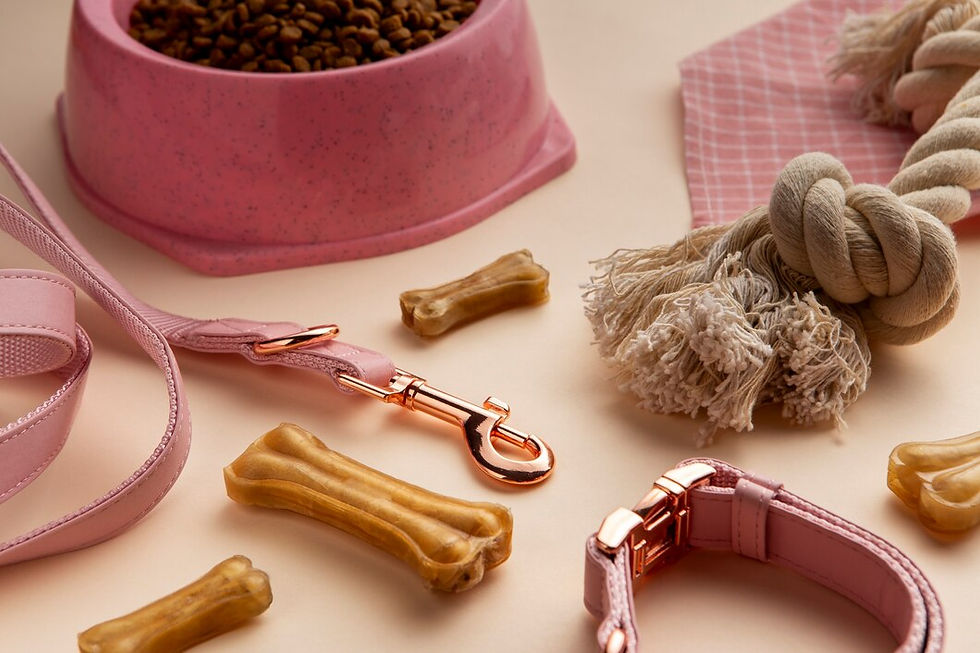Comprehensive Guide to Cleaning and Maintaining Your PVC Dog Collar
- Oliva Wilson
- Feb 5
- 4 min read
Do you ever find yourself pondering over the cleaning and maintenance of your beloved pet’s dog collar? Have you spent considerable time contemplating whether your PVC dog collar needs proper care or silently questioned if your dog collar cleaning technique is right? If you find yourself nodding to these queries or find them echoing your thoughts, you've landed in the right place. This blog post will explore the realms of keeping your PVC dog collar at its best, maintaining both its aesthetic appeal and functional utility.

Navigating through the aisles of a pet store or scrolling through the countless e-commerce platforms, the variety in the material of dog collars can leave one befuddled. You may find yourself question why one should go for a PVC collar, to begin with. This guide will serve its purpose in addressing such questions while making you adept at understanding the science behind PVC dog collar maintenance.
Key to our explorations is the PVC dog collar, dubbed for its durability and style. The Polyvinic Chloride material, otherwise known as PVC, finds itself a favorite among pet-parents and enthusiasts alike. But why? What is it about PVC that makes it stand out in a sea of alternatives like leather, nylon, or neoprene? One word – maintenance. Yet, it’s not merely about ease of cleaning, but also about the process, tips, and tricks and some myths. So let's dive in and get started on the maintenance journey of a PVC dog collar.
Unravelling the Mysteries: Why PVC?
The popularity of PVC dog collars is not an unexplored trend. The material is known for its hardiness and is resistant to weather, wear and tear, and even the occasional chews by your furry friend. The real question here is - why should your pooch and you choose PVC?
When it comes to dog collars, it’s not merely about enduring the test of time and sturdy products, but also about comfort. PVC collars are known for their comfortable fit, ensuring your dog can wear it throughout the day without any discomfort. Adding to the merits, these collars are available in a range of colours and designs, catering to your pet’s personality and style.
Lastly, PVC collars are eco-friendly, which is a crucial aspect as we battle ongoing environmental crises. These collars are made of recyclable material, aligning with the shift towards sustainable living.
The What and How of Cleaning: A Simple Guide
Often, pet-owners find themselves in a conundrum when it comes to cleaning their dog's collar. Even though the task seems simple, it’s about striking the perfect balance between cleaning efficiency and maintaining the collar’s integrity.
Firstly, take a soapy mix on a small brush or sponge. Gently, scrub away the dirt and grime accumulated on the collar. The magic trick here is to not put too much pressure while scrubbing. A gentle scrub will do just fine, ensuring your collar stays in great shape.
Rinsing the collar might seem like the easiest step but requires attention to detail. Make sure you rinse your collar thoroughly, leaving no trace of soap. Any leftover soap can cause irritation around your dog's neck.
Regular Maintenance: A Routine to Avoid Wear and Tear.
Regular maintenance of the dog collar can be reduced to simple steps incorporated into your routine. Wipe your collar once a day with a damp cloth to avoid dirt accumulation. If your dog loves to romp around nature, a bi-weekly cleaning schedule is advisable.
However, even with optimal care, PVC dog collars eventually wear out. It’s important to regularly check for any signs of deterioration like cracks or discolouration. Remember, a well-maintained collar contributes towards your pet’s safety.
Myths and Misconceptions: Unbiased Understanding
Although PVC dog collars are praised, they have their share of misconceptions. A popular one being that PVC collars cause discomfort and irritations. However, this largely depends on the quality of collar you choose; always go for high-grade PVC to avoid such issues.
Dos and Don'ts: Empowerment through Knowledge
There are certain dos and don’ts you must keep in mind when dealing with PVC collars. Never use heat or harsh chemicals for cleaning, as they can damage the material. Instead, opt for mild soaps and room temperature water. Moreover, avoid using abrasive surfaces for scrubbing, as it can result in the collar losing its sheen.

Exit Through The Dog Collar: A Wrap Up
Choosing a PVC dog collar doesn’t just end with making a purchase; it entails a specialised knowledge of upkeeping the collar so it retains its functionality and visual appeal. A PVC dog collar stands as a pragmatic choice for dog owners valuing style, convenience and sustainable choices. From understanding the why behind PVC’s popularity, delving into a meticulous guide on how to clean the collar and regular maintenance tips, to debunking myths and understanding what not to do – all contribute towards your knowledge about dog collar maintenance.
Remember, how you take care of your dog’s collar can turn it from an overlooked accessory to a statement piece that stands testament to your pet’s distinctive personality. The maintenance practices require consistency and are a blend of daily, weekly, and monthly tasks, coupled with a vigilant eye for any signs of wear and tear. In light of this information, may your dog's PVC collar continue to serve both fashion and function for longer durations.








Comments